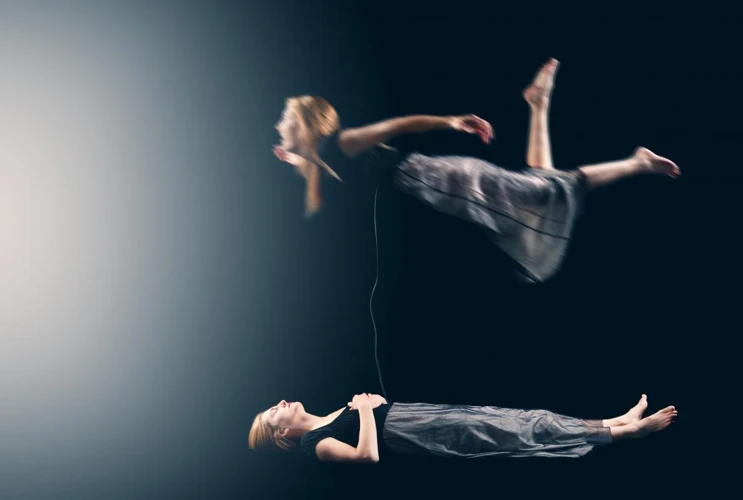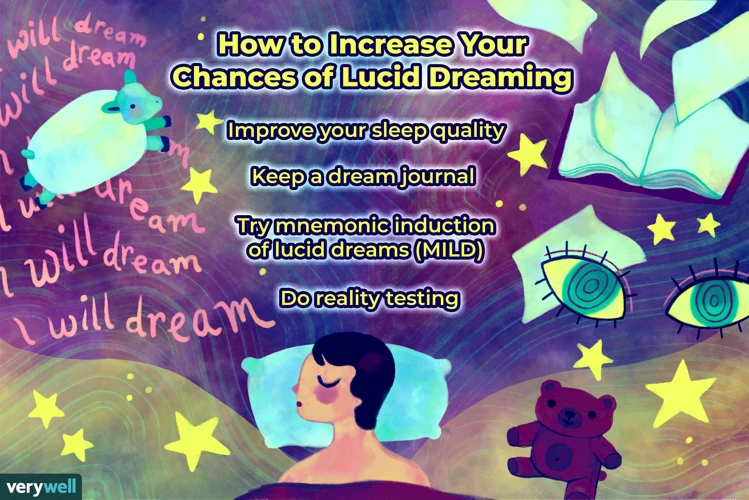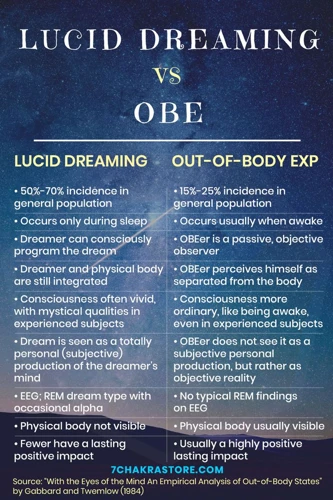Have you ever had an experience where you felt like you were floating outside of your body or found yourself in a dream where you were fully aware of the fact that you were dreaming? If so, you may have experienced either an out-of-body experience (OBE) or a lucid dream. These two phenomena are often misunderstood and confused with each other, causing confusion for those who have experienced them. In this article, we will explore the differences between OBEs and lucid dreams, including their definitions, common experiences, and methods for distinguishing between them. So grab a cup of coffee and join us on this journey to unravel the mysteries of the mind.
What are Out-of-Body Experiences?

Have you ever felt like you were floating above your own body, observing yourself from a distance? This strange phenomenon is known as an out-of-body experience (OBE). OBEs have perplexed and intrigued people for centuries, with some viewing them as spiritual experiences and others seeking scientific explanations. In this section, we will dive deeper into the definition of OBEs and the common experiences one may encounter during an OBE. So, let’s explore the mysterious world of out-of-body experiences together.
Defining Out-of-Body Experiences
Out-of-Body Experiences (OBEs) are defined as a phenomenon in which an individual feels as if they are consciously separate from their physical body, being able to witness their surroundings from an external vantage point. During an OBE, individuals feel a sense of detachment from their physical body and their consciousness seems to move away from their physical location. This can feel like an “out-of-body” experience where the individual feels like they are floating or hovering near their physical body.
It is important to note that OBEs are not the same as near-death experiences (NDEs), although some NDEs may involve an OBE. In an OBE, an individual can have a sense of control over their movements while in a NDE, the experience is often described as being more passive.
OBEs have been reported in different cultures throughout history and can occur spontaneously or induced through techniques like meditation or sensory deprivation. The existence of OBEs is still a matter of debate in the scientific community, and many theoretical explanations have been proposed to explain this phenomenon.
Common Experiences During an OBE
During an Out-of-Body Experience (OBE), a person may experience a variety of sensations and occurrences. Some of the most common experiences during an OBE include:
| Feeling like you’re floating or hovering | This is one of the most common sensations reported during an OBE. Those who experience an OBE may feel like they are floating above or outside of their physical body. |
| Looking down on your physical body | During an OBE, a person may report feeling like they are watching their physical body from above. This can be a very surreal experience, and many people report feeling a sense of detachment from their physical body during this time. |
| Experiencing heightened senses | Many people report that their sense of hearing and sight are enhanced during an OBE. Colors may appear more vivid, and sounds may seem louder or clearer than they do in waking life. |
| Feeling a sense of euphoria or calmness | Some people report feeling a profound sense of peace or joy during an OBE. This feeling of euphoria can be intense and may be accompanied by a sense of detachment from their physical surroundings. |
| Meeting deceased loved ones or other entities | During an OBE, a person may come into contact with deceased loved ones, spiritual entities, or other beings. These encounters can be both positive and negative, and may be accompanied by feelings of awe, fear, or wonder. |
Note: It’s important to note that not everyone who experiences an OBE will have all of these sensations or experiences. In fact, some people may not remember their OBE at all or may have only a few fleeting sensations. Additionally, OBEs can be difficult to objectively verify due to their subjective nature.
What are Lucid Dreams?

Have you ever found yourself fully conscious and aware that you’re dreaming? Your mind is alert, and you’re able to control the events happening in your dream world. This type of experience is called a lucid dream and can leave you feeling perplexed yet empowered. Unlike regular dreams, lucid dreams create a sense of control that allows you to reshape the dream-world environment and even your own actions. Let’s dive deeper into this phenomenon and explore what a lucid dream truly is.
Defining Lucid Dreams
A lucid dream is a type of dream where the dreamer is aware that they are dreaming. In other words, it is a dream in which the dreamer has control or partial control over their actions in the dream. During a lucid dream, the dreamer may be able to make conscious decisions and interact with the dream environment in a deliberate way. Unlike traditional dreams, where the dreamer is a passive observer, lucid dreams allow for an active and fully aware dream experience.
Characteristics of Lucid Dreams:
– Awareness: The defining characteristic of a lucid dream is an awareness of the fact that you’re dreaming. This means that you realize that you’re in a dream and that events and experiences are not real.
– Control: Since the dreamer is aware that they are dreaming, they have at least some level of control over the dream environment. This can mean changing the dream scenery, manipulating dream characters, or even changing one’s own appearance.
– Memory: Lucid dreams are often more vivid and memorable than regular dreams. The dreamer may remember the dream with greater detail, and can even recall it later in waking life.
– Duration: Lucid dreams can last different lengths of time and can be very brief or last for an extended period. Lucid dreams may also be revisited over multiple nights, allowing for the dreamer to continue to explore and manipulate the dream environment.
Lucid dreaming is a unique type of dream that allows the dreamer to have a heightened sense of control and awareness within their dream world.
Common Experiences During a Lucid Dream
During a lucid dream, a person is aware that they are dreaming and can often control or manipulate the dream in some way. Some common experiences that may occur during a lucid dream include:
| Experience | Description |
|---|---|
| Limited control | In some cases, the dreamer may have limited control over the dream. For example, they may be able to change the setting of the dream, but not the characters. |
| Exploration | Many lucid dreamers use their awareness of the dream to explore and try new things, such as flying or experiencing different sensory stimuli. |
| Emotional intensity | The emotions experienced during a lucid dream can be just as intense as those experienced during waking life, and may sometimes even carry over upon awakening. |
| Lack of consequences | Because the dream is not real, there are no real-life consequences to the actions taken within it, allowing the dreamer to take risks they might not otherwise take. |
| Infinite possibilities | The possibilities within a lucid dream are endless, limited only by the dreamer’s imagination and control. |
It is important to note that the experiences of a lucid dream can vary greatly between individuals and experiences. Some people may have more control over their dreams, while others may have only brief moments of awareness before slipping back into a non-lucid dream state.
How to Distinguish Out-of-Body Experiences from Lucid Dreams

One of the biggest questions surrounding out-of-body experiences and lucid dreams is how to differentiate between the two. It’s not always clear-cut, as both can involve similar experiences and sensations. However, there are certain distinguishing factors that can help determine whether someone is having an OBE or a lucid dream. In this section, we’ll explore these factors in more detail, using strong HTML tags for emphasis along the way.
Sensations and Emotions
To distinguish between out-of-body experiences and lucid dreams, one key factor to consider is the sensations and emotions associated with each state. During an out-of-body experience, individuals often report a sense of detachment from their physical body, and may feel as though they are floating or flying. This sensation of weightlessness can be accompanied by feelings of euphoria or intense fear, depending on the individual’s experience.
On the other hand, during a lucid dream, individuals may also experience a sense of detachment from their physical body. However, this detachment is often not as pronounced as it is during an out-of-body experience. Instead, individuals may simply feel as though they are in a dream state, rather than truly leaving their body.
| Out-of-Body Experiences | Lucid Dreams | |
|---|---|---|
| Sensations | A sense of detachment from the physical body, feeling weightless or floating | A sense of being in a dream state |
| Emotions | May experience euphoria or intense fear | Emotions may be similar to waking life, or may be influenced by the dream’s content |
Understanding the differences in sensations and emotions between these two states can be crucial in determining whether an individual is experiencing an out-of-body experience or a lucid dream.
Control and Awareness
Control and Awareness
One of the most significant differences between out-of-body experiences and lucid dreams is the amount of control and awareness one has during the experience. In an OBE, individuals often report feeling as if they are truly leaving their physical body and exploring the world around them in a manner that feels very different from dreaming. There is often a sense of clarity and intense focus, with individuals feeling that they are truly interacting with their surroundings.
In contrast, lucid dreams are more similar to regular dreams in that the individual is aware that they are dreaming, but often has limited control over the dream environment. They may be able to control themselves within the dream, but may not be able to change the dream environment or other characters within the dream in the same way that they can during an OBE.
To illustrate the difference between the two experiences on this dimension, consider the following comparison:
| Out-of-Body Experiences | Lucid Dreams | |
|---|---|---|
| Amount of Control | Individuals often feel a high degree of control, as if they are truly exploring the world around them. | Individuals may have some control over themselves, but less control over the dream environment as a whole. |
| Level of Awareness | Individuals in an OBE often report a heightened sense of awareness and clarity. | While individuals in a lucid dream are aware that they are dreaming, their level of awareness can vary and is often less intense than during an OBE. |
Understanding the difference in control and awareness experienced during an OBE versus a lucid dream can help individuals identify which experience they are having and gain a better understanding of their own consciousness.
Clarity and Realism
When trying to distinguish between out-of-body experiences (OBEs) and lucid dreams, it’s essential to consider the clarity and realism of the experience. The clarity refers to how clear and vivid the experience is, while realism refers to how real it feels.
Clarity refers to the quality of the experience itself. In an OBE, the clarity is said to be incredibly high. People report being able to see their surroundings with incredible detail, often exceeding normal waking perceptions. In contrast, dreams typically have a lower clarity level, where things may be fuzzy, blurry or unstable.
Realism, on the other hand, refers to the subjective feeling of the experience. OBEs are thought to have a high level of realism, with people often reporting that it feels as if they are having a real physical experience outside of their body. The surroundings feel tangible and physical, making it difficult to distinguish from reality. On the other hand, lucid dreams are said to feel less realistic overall, with dreamers acknowledging that the experience is not genuine, even if they are aware they are dreaming.
The following table summarizes the differences between OBEs and lucid dreams in terms of clarity and realism:
| Clarity | Realism | |
|---|---|---|
| Out-of-Body Experiences | High | High |
| Lucid Dreams | Low to medium | Low to medium |
It’s important to note that some people may have more vivid and realistic experiences than others. Additionally, the intensity of a dream or OBE may vary depending on the individual’s state of mind, emotions, and level of awareness. It’s important to look at other factors, such as sensations and emotions and control and awareness when trying to distinguish between OBEs and lucid dreams.
Why Understanding the Difference Matters
It is important to understand the difference between out-of-body experiences and lucid dreams because the two can be easily confused. Being able to distinguish between the two can help individuals have a better understanding of what they are experiencing mentally and physiologically.
One main reason why understanding the difference matters is that the experiences themselves tend to have different consequences on the individual’s mental health. For example, OBEs are often described as being more intense and realistic than lucid dreams. Individuals who experience OBEs often report that they feel like they are in a different world or dimension, which can be both exhilarating and terrifying. Lucid dreams, on the other hand, tend to be more controllable and less realistic.
Another reason why understanding the difference between the two is important is because OBEs and lucid dreams can have different impacts on the way the brain functions. Studies have shown that OBEs are linked to changes in the brain’s temporal lobe, which is responsible for processing sensory information and memory. Lucid dreams, on the other hand, have been linked to increases in activity in the prefrontal cortex, which is involved in decision-making and rational thinking.
Understanding the difference between OBEs and lucid dreaming can also help individuals to better understand the nature of consciousness and the human mind. Both experiences challenge our assumptions about the limits of our consciousness and the nature of reality. By gaining a better understanding of what OBEs and lucid dreams are, individuals can gain valuable insights into the workings of the human mind and the nature of reality itself.
Understanding the difference between out-of-body experiences and lucid dreams is crucial for individuals seeking to gain a deeper understanding of their own minds and the nature of consciousness. By being able to recognize the key differences between the two, individuals can better understand the experiences they have and gain valuable insights into the workings of the human mind.
Conclusion
In conclusion, while Out-of-Body Experiences (OBEs) and Lucid Dreams share some similarities, such as the feeling of being detached from the physical body, they are fundamentally different experiences.
OBEs involve the sensation of leaving the physical body, being in a different location, and often experiencing a sense of weightlessness or floating. On the other hand, Lucid Dreams occur while the dreamer is still in their physical body and aware that they are dreaming, which can lead to altering the dream environment to some extent.
The differences between these two experiences are essential to understand, as they carry significant implications for how we view consciousness, reality, and the nature of the human mind. Furthermore, understanding these differences can help us better interpret our own experiences and make informed decisions about how to interact with our dreams and consciousness.
Overall, the human experience is diverse and fascinating, and both OBEs and Lucid Dreams are just a couple of the intriguing aspects of our consciousness. Continued research and exploration of these phenomena can lead to a better understanding of ourselves and the world around us.
Frequently Asked Questions
1. Can an out-of-body experience be induced by meditation?
Yes, meditation is a common method used to induce an out-of-body experience.
2. Can a lucid dream turn into an out-of-body experience?
It’s possible for a lucid dream to turn into an out-of-body experience, but it’s not always the case.
3. Is there a scientific explanation for out-of-body experiences?
There is no consensus on the scientific explanation of out-of-body experiences, but some theories suggest that it’s a result of a breakdown in the brain’s normal processing of sensory information.
4. Can a person have a lucid dream without realizing it?
No, the defining characteristic of a lucid dream is that the dreamer is aware that they are dreaming.
5. Can drugs induce an out-of-body experience?
Some drugs have been known to induce an out-of-body experience, but they are illegal and can be dangerous.
6. Can lucid dreaming have therapeutic benefits?
Yes, lucid dreaming has been used in therapy to treat anxiety and post-traumatic stress disorder.
7. Can a person die during an out-of-body experience?
No, out-of-body experiences are not fatal, and the person usually returns to their body without harm.
8. Can everyone experience lucid dreaming?
Most people can learn to experience lucid dreaming, but some people have a harder time achieving it than others.
9. Can out-of-body experiences provide insights about the afterlife?
There is no scientific evidence to support this claim, and it remains a matter of personal belief.
10. Can lucid dreaming be used to enhance creativity?
Yes, some artists and writers use lucid dreaming as a way to access their subconscious and come up with new ideas.








